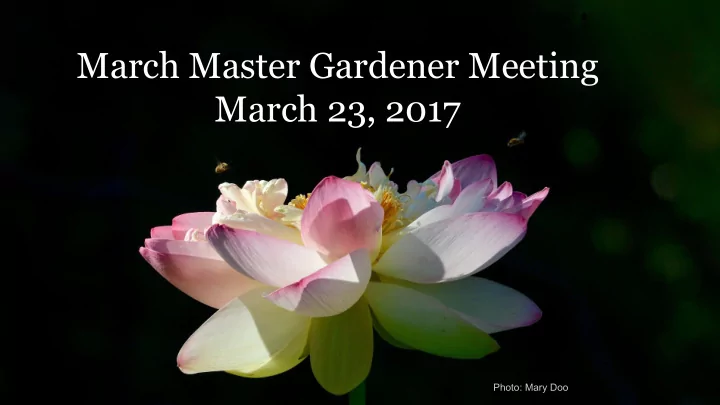

March Master Gardener Meeting March 23, 2017 Photo: Mary Doo
Tonight’s Agenda 6:00 Land Stewardship Focus Area 6:20 Resilient Landscapes, Dr. John Taylor 7:20 -Break- Volunteer Agreement, Guidebook 7:40 MGP Resources, Rosanne Sherry 8:10 - 8:30 Pin Award Ceremony Photo: Sue Dunn
Posting Continuing Ed Hours
Happy 40th Anniversary URI Master Gardener Program 1977- 2017!
URI Spring Festiva l Saturday, May 6, 2017 URI Kingston Campus
Gardening with the Masters Tour June 24-25, 2017 Guidebooks on sale today, please take bookmarks to distribute :)
URI Master Gardener Projects, School Gardens, EMG Services + Events → 15,000-20,000 clients educated in 2016!
Top 3 Behavior Changes We Encouraged in 2016 Year End Survey Results Clients began or increased the following: 1. Identify plant problems before taking action against them 2. Grow food plants 3. Amend soils correctly for vegetables, garden beds or lawn
What’s next in 2017?
Focus Area Why? An opportunity to concentrate our efforts strategic way toward a relevant issue facing RI communities.
Focus Area Process Step 3: Measure knowledge gain and Step 1: Train MG Volunteers Step 2: Educate the Public behavior change
Focus Area Development We consulted the following partners : ● Pollinator working group (RIDEM and RI House of Representatives) ● RI Invasive Species Council ● Civic Alliance for a Cooler RI ● RI Natural History Survey ● RI Wild Plant Society ● Sue Anderbois, Director of Food Strategy URI Faculty : ● Dr. John Taylor, Agroecology (URIMGP FACULTY ADVISOR) ● Dr Laura Meyerson, Natural Resource Science Department ● Brett Still, Natural Resource Science Department
Focus Area Development Where can we have biggest impact? THINK GLOBALLY ACT LOCALLY How can the URIMGP be value added to other efforts? What will our MGs be interested in? How can we fit within CE’s strategic plan?
41% land agriculture
54% land in US suburbs
30 million acres are lawn
5% is conservation land
Rhode Island is second most densely populated state
Rhode Island Lacks Invasive Species Regulation
82% woody invasive plants introduced through horticulture (Reichard 1997)
Native plants restore ecosystem functions
29% bee species in decline
35% agriculture pollinator dependent (1 in 3 bites)
< 1% insects are pests Photos: Mary Doo
80% expenditures for home/garden = insecticides Source: EPA Report: Pesticide Industry Sales and Usage 2008-2012 User Expenditures on Pesticides in the United States by Pesticide Type and Market Sector, 2012 Estimates
Lawns contribute 4x more nutrients (P, N) to stormwater than other land uses (Steuer et al., 1997; Waschbusch et al., 2000; Bannerman et al., 1993)
Year End Survey Biggest Area for Improvement Water Conservation
Pollinator Working Group for RI Findings ● We do not have an accurate inventory of pollinator species in Rhode Island ○ Citizen science Management Recommendations ● Pesticide Use ○ Promote selective use of pesticides – use the right tool for the right job.
PWG Management Recommendations ● Management ○ Enhance urban habitats for pollinators. ○ Increase fall flowering habitat. ○ Maximize soil health . ○ Leave bare ground as habitat for ground nesting native bees . ○ Maintain some brushy habitat for bees. ○ Avoid practices associated with high impact lawns . ○ Incorporate “weed” diversity .
Strategic Plan Land Stewardship Strategic Area of Focus Sub-goal 2: Increased capacity of...private landowners... to apply best stewardship practices to achieve ecosystem resilience and increase the use of effective, green infrastructure
Land Stewardship Sub-goal 4: Increased public awareness of the connections between economic viability, quality of life, environmental health , and food security resulting from land-use decision making
Focus Area: Land Stewardship 2017-2019 Photo: Sue Dunn Photo: Sue Dunn
Land Stewardship Behavior Change Goals 1. Recognize URI Cooperative Extension as a science-based resource 2. Preserve biodiversity and pollinators ○ Natives ○ Invasives ○ Pollinators 3. Conserve water and soil resources 4. Reduce pesticide use
Land Stewardship Continuing Education ● Jan Meeting Ecobeneficial Gardening, Kim Eierman - see recording ● Today! March 23 MG Meeting at 6pm - Resilient Landscapes, Dr. Taylor ● Climate Change Seminar (Recording)
Goal 1: URI Cooperative Extension as a Resource 1. Recognize URI Cooperative Extension as a science-based resource 2. Raise awareness of our services: ○ Hotline ○ Workshops ○ Soil Testing/Kiosk ○ Seeds
Goal 2: Preserve Biodiversity and Pollinators Behaviors to promote: ● Plant natives ● Avoid /remove invasives ● Habitat for pollinators and beneficial insects Photo: Sue Dunn Photo: Sue Dunn
Biodiversity and Pollinator Continuing Education ● April 27 Cont Ed class - Cutting Edge Pollinator Conservation, Scott MacIvor ● May 23 MG Meeting at 6pm - Pollinator Working Group Field Sessions ● Invasive removal and restoration at Canonchet, TBD ● Native plants, Rhody Native at Norman Bird Sanctuary, TBD
Themed Kiosk
Newport Harbor Walk Monarch Habitat Demo
Goal 3: Conserve Water Behaviors to promote: ● Use efficient irrigation methods ● Use plants to reduce stormwater runoff ● Mulch plants to reduce need for watering
Goal 3 (cont.) Conserve Soil Behaviors to promote: ● Test soil ● Amend soil properly ● Compost
Water and Soil Continuing Education ● Gardening for Water Quality in the Ocean State on (video recording) ● Advanced soil testing (video recording) ● Soil Health and Plant Nutrition Core Training on February 21 (video recording) ● Regenerative Landscape Design Core Training (video recording)
Goal 4: Reduce Pesticide Use (Integrated Pest Management) Behaviors to promote: ● Right plant for the right place ● Identify diseases/pests before taking action ● Use alternatives to pesticides whenever possible Photo: Sue Dunn
IPM Continuing Education Diagnostics Skill Building Series: Taught by URI Extension Staff ● Part 1 - Pest Updates and Resources - February 23 ● Part 2 - Trees, Shrubs and Perennials - May, 2017 ● Part 3 - Vegetables - August, 2017
Dr. Tayl0r
Recommend
More recommend